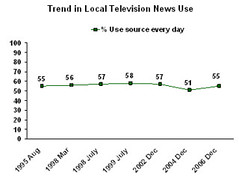Mean World: Local TV No. 1 News Source
This, in part, is why I am a print guy. I read the Avalanche-Journal almost every day. In contrast, I watch local TV news less than once a week (in some irony, it is on now).
Recent data suggests that I am alone. The Gallup Poll reports that, "Local TV Is No. 1 Source of News for Americans" (I believe this link will become pay only in a few weeks).
According to self-report data, 55% of Americans get their news from local TV news every day, whereas only 44% get news from local newspapers every day. Nightly network news is third with 35% of Americans.
There are so many interesting issues inherent in these data. Foremost is the weak link between TV news exposure and learning from the news. Some studies have even found a negative correlation between TV news exposure and current events knowledge (for example, see work by my former Ohio State colleague Gerald Kosicki).
Inseparable from this is the linkage between media usage and socio-economic status. In general, "elites" use print media, whereas those with lower incomes tend to get their news from television.
I get most of my news from the Internet (although most often the Web sites of print newspapers). Only 22% of my fellow Americans get news from the Internet every day, another connection with socio-economic status (the so-called digital divide).
The dominance of TV news is troubling for multiple reasons. First, there is my own bias (yeah, print!). More concerning is the brevity with which news items must be covered on television. There's no time to talk about a story for five minutes.
Covering issues with brevity makes issues especially susceptible to how they are presented (for example, framing). It logically follows that if I get only a few sentences about a given issues, then those sentences will be especially influential in my thinking about that issue.

Interestingly, this trend is static over time (see above chart courtesy of Gallup).
I was involved with studies examining the cognitive processing of local TV news while at Indiana University. In one study (Lang et al., 2005) , we found that faster pacing (i.e., more frequent camera changes) increased evaluations ... especially among younger viewers (you can find a link to this channel changing research study here).
Perhaps most helpful to local news producers are Annie Lang et al.'s "7 rules" for making news memorable without sacrificing factors that influence positive evaluations (Lang, Potter, & Grabe, 2003).
No matter how memorable local news can be, it's still not your daily paper. As a society, there is some cause for concern that the majority of Americans learn about the world from local newscasters.
Lang, A., Potter, D., & Grabe, M. E. (2003). Making news memorable: Applying theory to the production of local television news. Journal of Broadcasting & Electronic Media, 47, 113-123.
Lang, A., Shin, M., Bradley, S. D., Lee, S., Wang, Z, & Potter, D. (2005). Wait! Don't turn that dial! More excitement to come! The effects of story length and production pacing in local television news on channel changing behavior and information processing in a free-choice environment. Journal of Broadcasting & Electronic Media, 49, 3-22.
Labels: Indiana University, journalism, media, television




 FOLLOW SAM ON TWITTER
FOLLOW SAM ON TWITTER
 SUBSCRIBE TO THIS FEED
SUBSCRIBE TO THIS FEED

0 Comments:
Post a Comment
<< Home